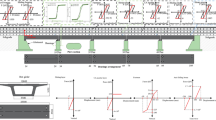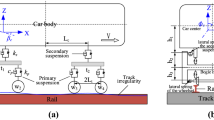Abstract
This study investigates the effects of horizontal ground motion incident angle on a high-speed railway continuous bridge (HSRCB). To that end, incremental dynamic analyses (IDA), seismic vulnerability analyses and seismic risk assessments were conducted on a three-span HSRCB subjected to a set of ground motions under five incidence angles θ (0°–90°). The analysis was developed only from the perspective of PGA and the results showed that the longitudinal waves (θ = 0°) only caused seismic responses in the longitudinal direction, while the waves in other directions, especially in the transverse direction, caused a coupling response both in longitudinal and transverse directions for some components, such as the sliding layer and CA mortar layer. The longitudinal seismic damage of the sliding layer and CA mortar layer under the transverse waves should receive more attention in seismic design since the exceeding probabilities and seismic risk probabilities under various incident angles θ are as high as the calculated value for θ = 0°, and with a variation within 5.95%. The maximum variation of the longitudinal response and probability for track parts was within 10.59% under various incident angles, with a significant difference in the transverse response and probabilities in response to different incident angles. In addition, the responses of bridge structure components were more sensitive to the incident angles in comparison with the track parts. Finally, results indicate that the risk probabilities are at a maximum when the ground motions fall within horizontal orientations of 67.5°–90° at the bridge longitudinal axis.
















Similar content being viewed by others
References
Mackie KR, Cronin KJ, Nielson BG. Response sensitivity of highway bridges to randomly oriented multi-component earthquake excitation. J Earthq Eng. 2011;15(6):850–76.
Ramanathan KN. Next generation seismic fragility curves for California bridges incorporating the evolution in seismic design philosophy. Georgia Instit Technol. 2012;12:20–34.
Taskari O, Sextos A. Multi-angle, multi-damage fragility curves for seismic assessment of bridges. Earthq Eng Struct Dyn. 2015;44(13):2281–301.
Moschonas IF, Kappos AJ. Assessment of concrete bridges subjected to ground motion with an arbitrary angle of incidence: static and dynamic approach. Bull Earthq Eng. 2013;11(2):581–605.
Banerjee Basu S, Shinozuka M. Effect of ground motion directionality on fragilitycharacteristics of a highway bridge. Adv in Civil Eng. 2011. https://doi.org/10.1155/2011/536171.
Magliulo G, Maddaloni G, Petrone C. Influence of earthquake direction on the seismic response of irregular plan RC frame buildings. Earthq Eng Eng Vib. 2014;13(2):243–56.
Ni Y, Chen J, Teng H, Jiang H. Influence of earthquake input angle on seismic response of curved girder bridge. J traffic and Transport Eng. 2015;2(4):233–41.
Soltanieh S, Memarpour MM, Kilanehei F. Performance assessment of bridge-soil-foundation system with irregular configuration considering ground motion directionality effects. Soil Dyn Earthq Eng. 2019;118:19–34. https://doi.org/10.1016/j.soildyn.2018.11.006.
Noori HR, Memarpour MM, Yakhchalian M, Soltanieh S. Effects of ground motion directionality on seismic behavior of skewed bridges considering SSI. Soil Dyn Earthq Eng. 2019;127:105820. https://doi.org/10.1016/j.soildyn.2019.105820.
Torbol M, Shinozuka M. Effect of the angle of seismic incidence on the fragility curves of bridges. Earthq Eng Struct Dyn. 2012;41(14):2111–24.
Araújo M, Marques M, Delgado R. Multi directional pushover analysis for seismic assessment of irregular-in-plan bridges. Eng Struct. 2014;79:375–89.
Bhatnagar UR, Banerjee S. Fragility of skewed bridges under orthogonal seismic ground motions. Struct Infrastruct Eng. 2015;11(9):1113–30.
Wang YD, Ibarra L, Pantelides C. Effect of incidence angle on the seismic performance of skewed bridges retrofitted with buckling-restrained braces. Eng Struct. 2020;211:110411.
Jeon JS, Choi E, Noh MH. Fragility characteristics of skewed concrete bridges accounting for ground motion directionality. Struct Eng Mechan. 2017;63(5):647–57. https://doi.org/10.12989/sem.2017.63.5.647.
Jiang C, Wei B, Wang D, Jiang L, He X. Seismic vulnerability evaluation of a three-span continuous beam railway bridge. Math Problems Eng. 2017. https://doi.org/10.1155/2017/3468076.
Li Y, Conte JP. Effects of seismic isolation on the seismic response of a California high-speed rail prototype bridge with soil-structure and track-structure interactions. Earthq Eng Struct Dyn. 2016;45(15):2415–34.
Yan B, Liu S, Pu H, Dai G, Cai X. Elastic-plastic seismic response of CRTS II slab ballastless track system on high-speed railway bridges. Sci China Tech Sci. 2017;60(6):865–71. https://doi.org/10.1007/s11431-016-0222-6.
People’s Republic of China National Railway Administration (CNRA-PRC). Code for Design of High Speed Railway (including itsexplanation) (TB 10621–2014). China: China Railway Press; 2014.
He X, Wu T, Zou Y, Chen YF, Guo H, Yu Z. Recent developments of high-speed railway bridges in China. Struct Infrastruct Eng. 2017;13(12):584–1595. https://doi.org/10.1080/15732479.2017.1304429.
Yan B, Dai GL, Hu N. Recent development of design and construction of short span high-speed railway bridges in China. Eng Struct. 2015;100:707–17.
People’s Republic of China Ministry of Railway (CMR-PRC). Code for seismic design of railway engineering (GB 50111–2006). Beijing: China Planning Press; 2006.
People’s Republic of China Ministry of Transport (CMT-PRC). Guidelines for seismic design of highway bridges (JTG/TB02–01–2008). Beijing: China Communications Press; 2008.
Tekie PB, Ellingwood BR. Seismic fragility assessment of concrete gravity dams. Earthq Eng Struct Dyn. 2010;32(14):2221–40.
Cornell CA, Jalayer F, Hamburger RO, Foutch DA. Probabilistic basis for 2000 SAC federal emergency management agency steel moment frame guidelines. J Struct Eng. 2002;128(4):526–33.
Hwang H, Liu JB, Chiu YH. Seismic fragility analysis of highway bridges. Mid-America: Mid-Ameirica Earthq Center Technical Report; 2001.
Ramanathan K, DesRoches R, Padgett JE. Analytical fragility curves for multispan continuous steel girder bridges in moderate seismic zones. Trans Res Record. 2010;2202:173–82.
Nielson BG. Analytical fragility curves for highway bridges in moderate seismic zones. Atlanta, GA: Georgia Institute of Technology; 2005.
Gao XW, Bao AB. Probability model of earthquake action and its statistical parameters. Earthq Eng EngDyn. 1985;01:15–24.
Shibata A. Prediction of the probability of earthquake damage to reinforced concrete building groups in a city. In: Proceedings of the 7th World Conference on Earthquake Engineering; 1980. p. 395–402.
State Seismological Bureau. Earthquake intensity zoning map of China. Beijing: Seismological Press; 1990.
Deierlein GG, Krawinkler H, Cornell CA. A framework for performance-based earthquake engineering. In: 7th Pacific Conference on Earthquake Engineering, vol. 273; 2003. p. 1–8.
Ministry of Transport of the People’s Republic of China (MOT-PRC). Specifications for design of highway reinforced concrete and prestressed concrete bridges and culverts (JTG 3362–2018). Beijing: China Communications Press; 2018.
TB10015-2012. Code for design of railway continuously welded rail. Beijing: China Railway Press; 2013.
Manual O. Open system for earthquake engineering simulation user command-language manual. Berkeley: Pacific Earthquake Engineering Research Centre University of California; 2009.
Mander JAB, Priestley MJN. Theoretical stress-strain model for confined concrete. J Struct Eng. 1988;114(8):1804–26.
Filippou FC, Popov EP, Bertero VV. Effects of Bond Deterioration on Hysteretic Behavior of Reinforced Concrete Joints. Report EERC 83–19. Berkeley: Earthquake Engineering Research Center University of California; 1983.
Dai GL, Liu WS. Applicability of small resistance fastener on long-span continuous bridges of high-speed railway. J Central South Univ. 2013;20(5):1426–33.
Wei B, Yang TH, Jiang LZ, He XH. Effects of uncertain characteristic periods of ground motions on seismic vulnerabilities of a continuous track–bridge system of high-speed railway. Bull Earthq Eng. 2018;16(9):3739–69. https://doi.org/10.1007/s10518-018-0326-8.
Naeim F. Seismic Design Handbook. 2001. https://doi.org/10.1007/978-1-4615-1693-4.
Idriss IM. Influence of Local Site Conditions on Earthquake Ground Motions Proc 4th US Nat Conf on Earthq Eng. California: Palm Springs; 1990.
Mohraz B. A study of earthquake response spectra for different geological conditions. Bull Seism Soc Am. 1976;66(3):915–35.
Seed HB, Idriss IM. Ground Motions and Soil Liquefaction During Earthquakes. Berkeley, California: Earthq Eng Research Inst; 1982.
Wei B, Li CB, He XH. The Applicability of Different Earthquake Intensity Measures to the Seismic Vulnerability of a High-Speed Railway Continuous Bridge. Inter J Civil Eng. 2019;17(7A):981–97. https://doi.org/10.1007/s40999-018-0347-3.
Biao W, Chengjun Z, Xuhui H, et al. Effects of vertical ground motions on seismic vulnerabilities of a continuous track-bridge system of high-speed railway. Soil Dyn Earthq Eng. 2018;115:281–90. https://doi.org/10.1016/j.soildyn.2018.08.022.
Vamvatsikos D, Cornell CA. Developing efficient scalar and vector intensity measures for IDA capacity estimation by incorporating elastic spectral shape information. Earthq Eng Struct Dyn. 2005;34(13):1573–600.
Hwang H, Jernigan JB, Lin YW. Evaluation of seismic damage to Memphis bridges and highway systems. J Bridge Eng. 2000;5(4):322–30.
Park YJ, Ang AHS. Mechanistic seismic damage model for reinforced concrete. J Struct Eng. 1985;111(4):722–39.
Zhong J, Pang YT, Jeon JS, Desroches R, Yuan WC. Seismic fragility assessment of long-span cable-stayed bridges in China. Adv Struct Eng. 2016;19(11):1797–812.
Kowalsky MJA. Displacement-based approach for the seismic design of continuous concrete bridges. Earthq Eng Struct Dyn. 2002;31(3):719–47.
Wei B, Hu ZL, He XH, Jiang LZ. Evaluation of optimal ground motion intensity measures and seismic fragility analysis of a multi-pylon cable-stayed bridge with super-high piers in mountainous areas. Soil Dyn Earthq Eng. 2020. https://doi.org/10.1016/j.soildyn.2019.105945.
Acknowledgements
This research was jointly supported by the National Natural Science Foundations of China under grant No. 51778635 and 51778630, the Research Program on Key Technology for the Seismic Design of Railway Bridge in Nine Degree Seismic Intensity Zone under grant No. KYY2018059 and the Fundamental Research Funds of Central South University under grant No.2019zzts285. The above support was greatly acknowledged.
Funding
This research was jointly supported by the National Natural Science Foundations of China under grant No. 51778635 and 51778630, and the Fundamental Research Funds of Central South University under grant No.2019zzts285. The above support was greatly acknowledged.
Author information
Authors and Affiliations
Corresponding author
Ethics declarations
Conflict of interest
The authors declare that they have no known competing financial interests or personal relationships that could have appeared to influence the work reported in this paper.
Ethical approval
This article does not contain any studies with human participants or animals performed by any of the authors.
Ethics statement
Some of the same drawings in this paper are refer to these two articles published in “Bulletin of Earthquake Engineering” and “International Journal of Civil Engineering”, where those data have already been published [38, 43].
Additional information
Publisher's Note Springer Nature remains neutral with regard to jurisdictional claims in published maps and institutional affiliations.
Rights and permissions
About this article
Cite this article
Wei, B., Hu, Z., Zuo, C. et al. Effects of horizontal ground motion incident angle on the seismic risk assessment of a high-speed railway continuous bridge. Archiv.Civ.Mech.Eng 21, 18 (2021). https://doi.org/10.1007/s43452-020-00169-0
Received:
Revised:
Accepted:
Published:
DOI: https://doi.org/10.1007/s43452-020-00169-0




